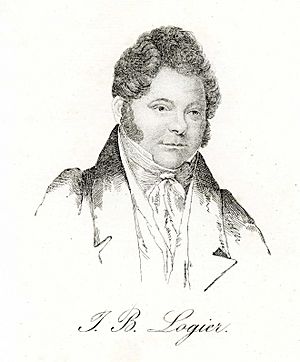Johann Bernhard Logier facts for kids
Johann Bernhard Logier (born February 9, 1777 – died July 27, 1846) was a talented German musician. He was a composer, teacher, inventor, and even a publisher. Logier spent most of his life living and working in Ireland.
Logier's Life Story
Logier was born in Kassel, Germany. His father, who was a violinist, first taught him music. In 1791, when he was about 14, Logier moved to England. He joined a military band, playing the flute. Later, he became the director of this band.
In 1802, Logier moved to Ireland with his regiment. He became an organist in Westport. By 1808, he was leading the band for the Kilkenny Militia. A year later, he became the music director for the Royal Hibernian Theatre. He then opened a successful music shop in Dublin.
Except for a few years in Berlin (1822–1826), he lived the rest of his life in Dublin. He passed away there in 1846.
The Chiroplast Invention
Logier invented something special called the Chiroplast. This was a sliding frame designed to help people learn to play the piano. It guided their hands and fingers. The goal was to improve how hands and wrists were positioned.
He showed off his invention in public. He also wrote books and studies about his ideas. Soon, his method became very popular. Logier even got a patent for the Chiroplast. This meant he could earn money from teachers who used his method.
"Chiroplast instruction centres" opened in many cities. These included Dublin, London, Paris, and Berlin. Famous musicians like Kalkbrenner and Spohr supported his invention. By 1824, one music shop in London had sold 1,600 Chiroplasts!
Logier's Teaching Method
Logier also created his own way of teaching music. It was later called the Logierian System of Musical Education. He shared his ideas in a series of books. The first one was called An Explanation and Description of the Royal Patent Chiroplast or Hand-Director (1816).
In his method, several students were taught at the same time. They learned technical skills together. They also learned about the rules of harmony in music. Logier's approach helped create the idea of group music lessons.
In 1827, Logier published a big textbook. It was called System of the Science of Music, Harmony, and Practical Composition. This book was used a lot throughout the 1800s. He also wrote the first book about playing the Royal Kent Bugle in 1813.
Logier's Music
Logier was a composer, but his inventions and teaching methods were more famous. Many short stories about him don't even mention his music. He wrote pieces for piano, flute, harp, bugle, and military bands. He also arranged popular songs for solo piano.
One of his biggest works was an opera called Brian Boroihme (1810). This opera was about an Irish historical event. It was quite successful and important for Irish opera. He also wrote a challenging concerto for piano and orchestra in 1816.
Logier liked to make his performances grand. For his Battle of Trafalgar (1810), he brought together seven military bands! For The Battle of Vittoria (1813), he had 150 musicians playing.


